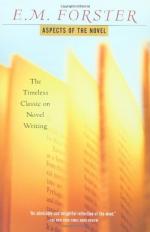|
This section contains 247 words (approx. 1 page at 400 words per page) |

|
Aspects of the Novel Summary & Study Guide Description
Aspects of the Novel Summary & Study Guide includes comprehensive information and analysis to help you understand the book. This study guide contains the following sections:
This detailed literature summary also contains Bibliography and a Free Quiz on Aspects of the Novel by E. M. Forster.
Aspects of the Novel is the publication of a series of lectures on the English language novel, delivered by E. M. Forster at Trinity College, Cambridge, in 1927. Using examples of classic works by many of the world's greatest writers, he discusses seven aspects he deems universal to the novel: story, characters, plot, fantasy, prophecy, pattern, and rhythm.
Forster dismisses the method of examining the novel as a historical development, in preference to an image of all novelists throughout history writing simultaneously, side by side. He first establishes that, if nothing else, a novel is a story that takes place over a period of time. He stresses the importance of character, maintaining that both "flat" and "round" characters may be included in the successful novel. He regards the necessity of plot, which creates the effect of suspense, as a problem by which character is frequently sacrificed in the service of providing an ending to the novel. Fantasy and prophecy, which provide a sense of the "universal," or spiritual, Forster regards as central aspects of the great novel. Finally, he dismisses the value of "pattern," by which a narrative may be structured, as another aspect that frequently sacrifices the vitality of character. Drawing on the metaphor of music, Forster concludes that rhythm, which he defines as "repetition plus variation," allows for an aesthetically pleasing structure to emerge from the novel, while maintaining the integrity of character and the open-ended quality that gives novels a feeling of expansiveness.
Read more from the Study Guide
|
This section contains 247 words (approx. 1 page at 400 words per page) |

|



